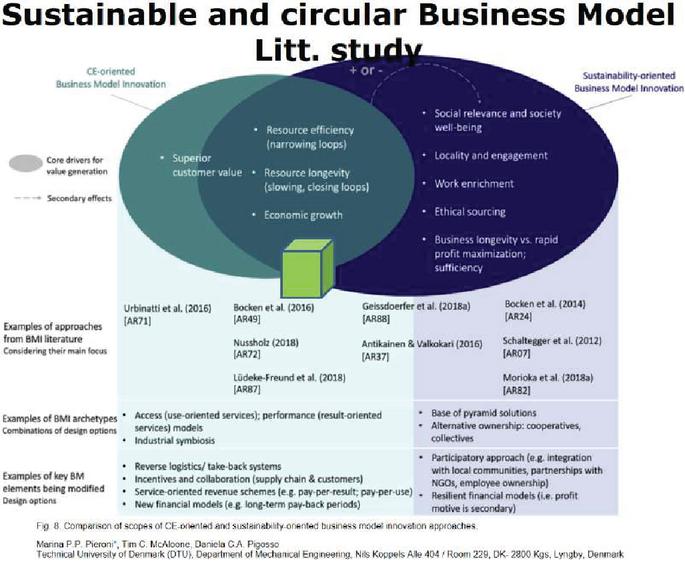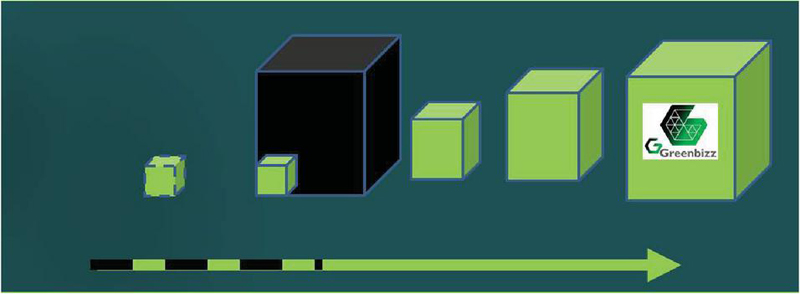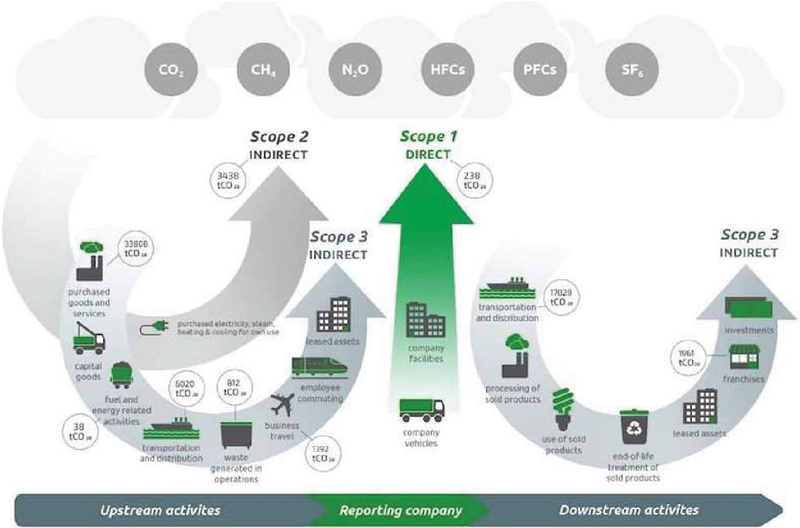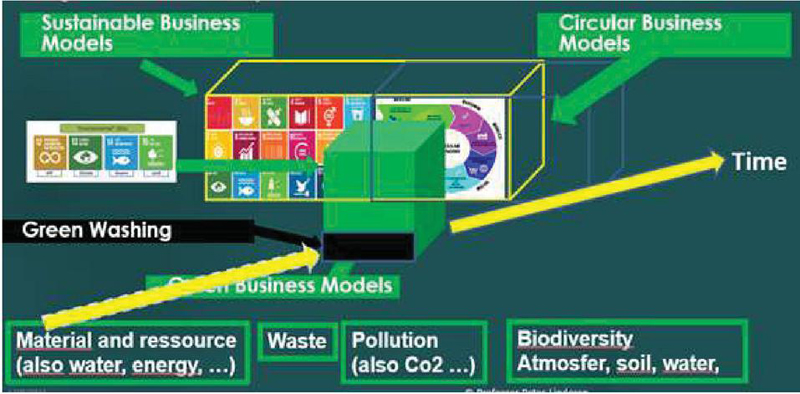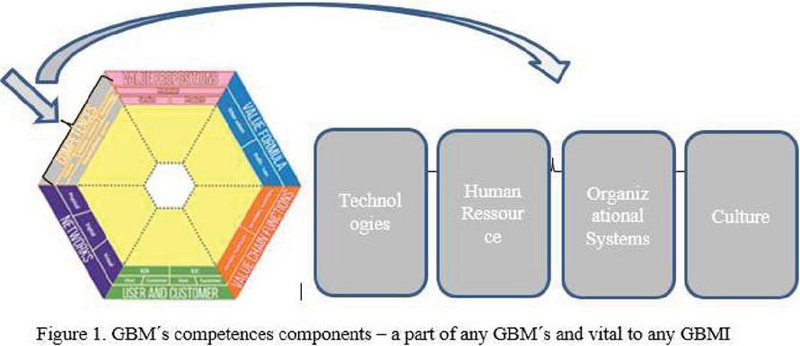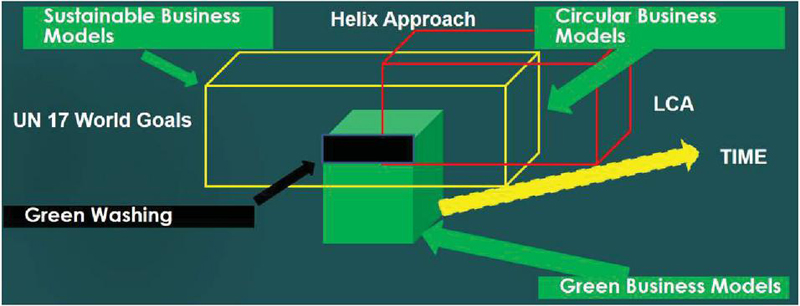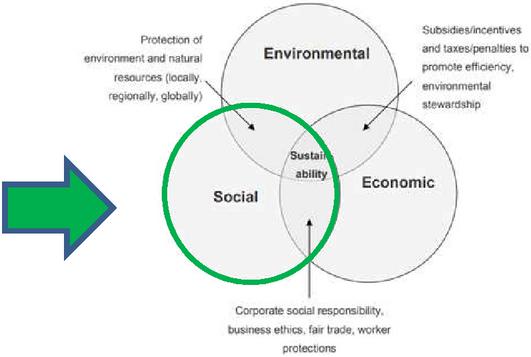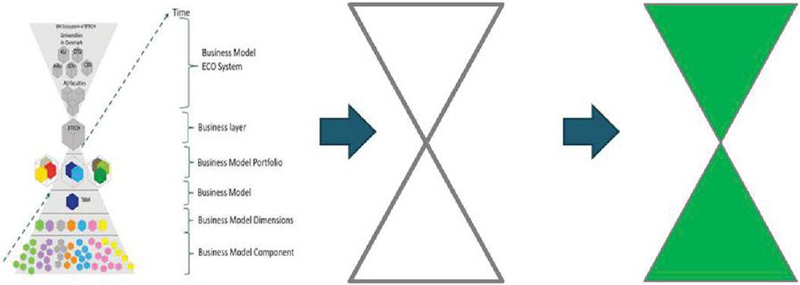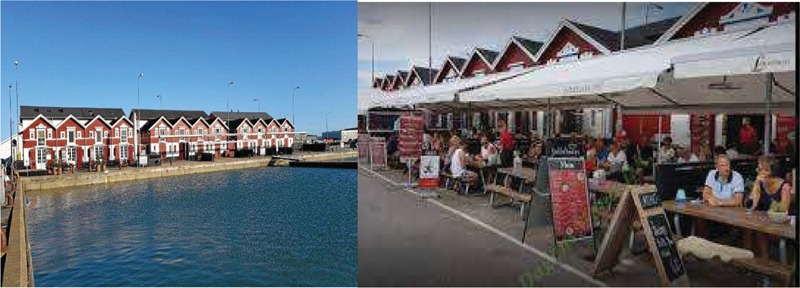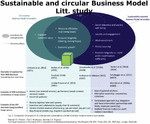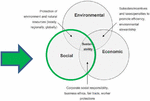Circular Green and Sustainable Business Model Competence Innovation and Development: Challenges with Privacy and GDPR Related to Businesses and Research
Peter Lindgren
Peter Lindgren CTIF Global Capsule, Kuttervej 13, DK-9990 Skagen Denmark
E-mail: lindgren.peter@ctifglobalcapsule.org
Received 14 September 2023; Accepted 17 April 2024
Abstract
Increased focus and vision on faster circular green and sustainable transformation in businesses and research have now turned out to be highly linked to also the social and the competence dimension of “the triple bottom line” approach and measurements. The social economic part of the triple bottom line approach has shown to be increasingly important, but very challenging to operate under the existing Privacy and GDPR regulations. To fulfil and measure how green the human, organizational systems and culture competence components actually are in business models today is not that much investigated. Focus has more been on “greening” the technology part of the competence components but now a number of advanced technologies seems promising to help measure green competences. It opens up for measuring circular, green and sustainable business model competences in some new and more advanced ways, but it could potentially result in the business do not comply with Privacy and GDPR regulations.
Ever since the branching of the scholarly literature on competences of the early 1960’s businesses have constantly being experimenting with business model competence design, reengineering, development and measuring. Creating Green Business Model (GBM’s) competences is no exception. Designing TO BE GBM’s and reconfiguration of AS IS BM’s to become GBM’s and later develop these is in focus – but until now the main focus has been on greening technologies. Very few knows how to “greening” and measure green related to human competences, organizational systems and culture. GBM competence reconfiguration has also mainly focused on changing or reconfiguring AS IS Business Models technology competences.
More and more businesses have realised that investing in new technologies or changing existing technologies are not enough to reach the vision and goals of green transformation. Technologies alone cannot release the full potential and requests of green transformation – reduce the use of material and resources, reduce the waste and spill, reduce the pollution including Co2 and increase biodiversity. The Business will simply not by technologies alone be able “to climb” and “pass” “the Green Wall” without innovating, developing the BM competences – HR, Organizational systems and Culture into becoming greener and thereby support green transformation in the businesses.
Reconfiguring AS IS business model competences to become greener is complex and calls for new and advanced approaches that challenge classical BM competence frameworks and understanding. Green Parameters and Profit are no longer the main focus in GBMI and changing some BM dimensions and components – or even adding new business model dimensions to the BM is neither enough. If business want to remain competitive, efficient and at the same time green, it requires a different GBMI approach and mindset – including measuring BM Competences. This challenges the compliance of Privacy and GDPR related to both businesses and research. The request for circularity and sustainability just adds to the complexity of measuring.
We offer a review of three Privacy and GDPR GBMI compliance cases and challenges in three different businesses with the aim of achieving greater understanding of Privacy and GDPR challenges both for businesses and researchers. We identify issues behind the apparent challenges of Privacy and GDPR in GBMI and discuss how strategic GBMI can contribute to further research on Privacy and GDPR in different fields of Green Business Modelling, offering future research directions of Privacy and GDPR.
Keywords: Privacy, GDPR, strategic green multi business model competence innovation, green business model competences, green business model competence behaviour.
1 Introduction
Green Business Models Innovation (GBMI) and Development have in 2020 – 2023 truly focused both regional (ECSMV 2022)[1], national (Energy Islands 2021)[2] – and international (McKinsey 2022)[3] (UN 2022)[4] (IPC1 2022)[5] (IPC2 2022)[6] on heavy green technology investments. This is intended to continue through 2024 – 2035 as GBMI challenge concern most societies – not just Nordic countries[7] but also globally [8, 9] because of the major and serious global climate change challenge. The Global Society therefore pushes businesses to focus more on Green, GBMI, Green Business Model (GBM) – and Green BM Competence Innovation and Development[10]. The different nations change and tightens continuously the ruleset of different business model ecosystems (BMES) (Lindgren 2016)[11] and announce new and more restrictive rulesets (EU taxonomy 2021)[10] to “force” and “motivate” businessses to become more green (EU Greendeal 2019[8]; (Greenlab 2022)[12]; Greenlab[13] (SETII 2022)[14]; (Greenbizz 2022)[15]; (Climatorium 2022)[16]; (Circuit 2022)[17]; EU CoE Transmission 2021)[18], sustainable (19) and circular (20).
The Danish government targets a 70% Green House Gas (GHG) emissions reduction in 2030 in businesses compared to 1990 and a net zero emission by 2050 at the latest (Danish Ministry of Climate Energy and Utilities, 2019)[21]. Startups and Small and Medium Size Enterprises (SME)’s are vital to fulfil the government and societies goals, as they count for more than 92% of all businesses in Denmark and thereby a large percentage of the total CO emission. The EU counts 23 million SMEs, employing around 100 million people and accounting for more than half of Europe’s GDP. However, their collective share in total emissions is high, at 63% of all CO2 emissions by businesses (18) in 2021.
The goal for 20% energy efficiency and 70% carbon reduction by 2030 drove many businesses and BMES into strategies that incorporated GBM, GBMI designs and reconfigurations. Businesses were highly concerned about the efficiency of this vision, the GBM’s and GBMI – and how they could lead and manage (Sommer 2012)[22] GBM and GBMI competences. BM competences, (Prahalad 1997)[23] (Lindgren 2018)[24] have been proposed to consist of Technology, Human Resource, Organisational System and Culture. Technology has in the GBMI context according to research (Lindgren 2021)[11] been the BM Competence Component most in focus in SME’s. However, as more and more businesses face a “Greenwall” (Sarker 2022)[25] they have now begun to turn to other components of their BM Competences – Human Resource, Organisational System and Culture. They have discovered that the new GBM measurement technologies enable them to download, see and sense their BM Competences and their behavior – “Green Business Model Behavior” – of machines, employees, users, customers and networks. This challenges however the rulesets and compliance of privacy and GDPR.
2 Strategic Green Business Model Competence Innovation and Development
Whether business modelist and business strategy scholars consider GBM competence innovation, GBM competence innovation strategy research and GBM behavior as a new and important field is related to the fact that the BM competence perspective until now is challenged by the assumptions of traditional linear BM competence theories, frameworks and practice [26–30]. This focuses on limited parts of the GBM competence and GBMI competence spectrum – mainly GBM competence creation, especially creation of GBM technologies. It further does not focus particularly on all possible business model innovation levels and combinations of BM’s – the Strategic Multi Green Business Model Innovation – and the development approach. It is mainly related to the convincement of the linear and single business model approach. It takes its point of entry in business model innovation and competence innovation approach of the 2000’s, where business model communities, researchers and practitioners mostly use the approach that existing business model frameworks and concepts can be used also on GBM, Sustainable Business Models (SBM) and Circular Business Models (CBM).
However, some contributions have been made lately that challenge the linear green business model approach to change into a circular GBM as seen in Figure 1.
Figure 1 A circular green business model innovation approach green-, sustainable- and circular business model literature study[31] inspired by Bocken[19] and Peroni[20].
Different interpretations of the meaning and function of “Green business models” have emerged from the literature[32]. A debate on the relations between “black”, half black and GBM’s – both on TO BE and AS IS BM’s (Figure 2) – has appeared on the backside of the increasing discussion on green washing [34, 35].
Figure 2 An exemplified journey of the green business model – from black, to half black to Green[32].
However, the discussion has until now been very limited – although it fascinates an increasing number of business modelists, strategists and scholars.
3 Research Questions Related to Strategic Circular, Sustainable and Green Business Model Competence Design, Reengineering and Development
The purpose of this study is to review the existing body of knowledge about circular, sustainable and Green Business Model scientific literature to detect possible answers to
How can Circular, Sustainable and Green business model competences be measured across BM value network? – Scope 3 approach[10]
How can Circular, Sustainable, and Green business model competences be measured on the different layers of business model innovation[11]
How can Circular, Sustainable and Green business model competences be measured in the Business and its related Business Models …in compliance with regulations of Privacy and GDPR ? [19, 20, 32]
4 Circular, Sustainable Green Business Model (CSGBM) Competence Design, Reengineering and Development
No doubt – CBM, SBM and GBM’s must aim at providing businesses circular, sustainable and green advantage and progress – but also economic sustainable, efficient and competitive businesses advantage. However, CBM, SBM and GBM are not just about economic parameters, but have also to be about non-monetary parameters. CBM, SBM and GBM parameters like – 1. Resources and Materials 2. Waste and Spill 3. Pollution included CO 4. Biodiversity inside the single business. They have also to take into account measuring green, circularity and sustainability across BM competences and across the value network to meet the requirements of Scope 3 – as shown in Figure 3 – in EU’s Taxonomi[10].
Figure 3 Scope 1 – 2 and 3 adapted from sustainable lab[36].
This will also support businesses to get closer to create Circular Sustainable Green Business Models (CSGBM) and possible prevent Greenwashing.
Figure 4 Circular sustainable and GBM competence components related to green parameters.
Our hypothesis is that Pure Circular Sustainable Green Business Models (CSGBM) as shown in Figure 4 seem to differentiate itself compared to just a SBM, CBM, GBM and a linear business model as it is a journey where the third axis of the triple bottom line – the social economic parameter – is also included, and taken seriously into consideration and considered as equally important as the Environmental and Economical parameters. Our hypothesis is that linear, sustainable and circular business model competences are not necessarily purely circular, sustainable and green on all components. Therefore, we have “to come closer to do measurements close to real time to verify if BM’s are really circular sustainable and green – and if they stay that, evolving over time – over their lifecycle. This – we argue – cannot be done by just at a yearly certification process – like the Green Key Certficate[37] and other certificates as these are stationary, measured yearly and on a one time basis.
Figure 5 GBM’s competence components – a part of any GBM’s and vital to any GBMI.
Many countries have created compliance frameworks for renewable energy generation. Energy producers and importers under these frameworks must supply and guarantee a minimum amount of renewable energy annually to the grid or purchase renewable energy quota certificates generated by other producers. Quota certificates help to subsidize renewable energy for market players. So many products and so much extensive compliance knowledge exist to help businesses to navigate the complex and ever-shifting regulatory landscape. Many businesses support their clients in complying with regulatory obligations with different products and services related to use of materials and resources, LCA, recycling of materials, type of energy used – black and green energy, Energy efficiency, waste reduction, waste construction, pollution – low carbon emission, Business Model (BM) collaboration types, sustainable business models, circular business models, UN 17 Goals[38] All are topics, terms, standards and certificates that have been related in the past to the discussion on green business models. All topics are more or less being related to the term green and in this case green economy, green business, green business models and green technology. SBM’s[19] and CBM’s[20] communities have tried to embed the GBM’s into their terms and vocabularies – however with great difficulties especially when some SBM’s and CBM’s turns out not to be green when deep and further investigated – both in short and long term perspective[11].
Figure 6 Circular green business models related to discussed topics[11].
Here enters the discussion on trust to the circularity, sustainability and greenness of a business model and those handling or operating the CSGBM for the business – How green are the business competences in reality? Are the employees, the organisational systems and the different cultures of the businesses really green – and really acting green. This is a question today that addresses trust and trust to the certificates, standards and the business competences – selling the certificates and the GBM’s.
According to the literature, there are several ways to identify what makes a business model green:
By focusing on the impact of products, services, processes – the value propositions of the BM’s – and these seen as a part of the value chain – scope 3 (36). GBM’s are “business models which support the development of value propositions with environmental benefits, reduce material and resource use, no or less waste, less or no pollution and better or optimum biodiversity and which are economically viable and sustainable. GBM’s have a lower environmental impact than traditional business models and a business can be considered green by producing green value propositions or by greening their own business model process or parts together with their value network partners. GBM involve efficient value propositions, in this case the green effect is on deployment, use, and maintenance phase of the BM’s value proposition and contribute to the reduction of the ecological footprint by sharing resources or using waste, spill and pollution as a resource in a GBM. The greening of the value proposition processes means limiting the ecological footprint of the business.
By focusing on Green Multi Business Model Innovation a business together with its value network partners changes components, dimensions of its business models and thereby both captures economic value, reduces the ecological footprint in a life-cycle perspective and generally, it can be said that (1) the more components and dimensions of a business model which are changed and have a green effect, and (2) the more profoundly green change is taking place within the individual components and dimensions of the business model – going from reconfiguration, re-design to development – the greener the business model innovation is and the higher potential for creating incremental, radical and disruptive GBMI.
Inspired by Bocken (42) business model innovations for CSGBM can be defined as:
Innovations that create significant positive and/or significantly reduce negative impacts for the environment and/or society, through changes in the way the business and its value-network create, capture, deliver, receive and consume value and create economic and social value or change their value propositions.
5 Circular, Sustainable and Green Business Model Competence Measurement by Advanced Technologies
Our hypothesis is that advanced technologies combined with other tools and frameworks can “sense” and “measure” quite precisely if CSGBM Competences are really green. 5G and 6G technologies give us opportunities and hopes to be able to fulfil our societies’ vision to really measure CSGBM on all three parameters – environmental, economic and social dimensions.
But – are we allowed to do this – at the same time – in the context of Privacy and GDPR compliance. If so, can we comply with the rulesets of Privacy and GDPR?
All topics address the Global Societies vision and goals to become a circular sustainable green economy – 100% CO neutral – e.g. EU’s latest Horizon Europe’s call[8]– The Green Deal Calls[8] and the Chinese Governments Co2 neutral goal of 2020[43] combine with the “Triple bottom line” (Elkington 1994) challenge today measurements, leadership, management and trust to the green transformation.
Figure 7 Triple bottom line and the green social dimension inspired from rosen’s model (Rosen 2012), Ocampo Lanndon (2015) and Elkington’s original model (Elkington 2018).
Eight thematic areas were identified reflecting the key work streams of the European Green Deal:
Table 1 EU Horizon 2020 Green Deal key work streams
| Increasing climate ambition | Sustainable and smart mobility |
| Clean, affordable and secure energy | Farm to fork |
| Industry for a clean and circular economy | Biodiversity and ecosystems |
| Energy and resource efficient buildings | Zero-pollution, toxic-free environments |
Two horizontal areas aim at strengthening knowledge and empower EU – citizens in the Green Deal addressing a longer-term perspective in achieving the transformations set out in the European Green Deal. The European Green Deal is the European Commission’s blueprint and roadmap to make Europe the first climate neutral continent – already by 2050, with a sustainable economy – although heavy investment in GBMI – leaves no one behind. To reach this 2050 vision and goals, EU has elected to following actions in all BMES[44], including:
Table 2 EU horizon 2020 green deal actions[5]
| Investing in environmental-friendly technologies; |
| Supporting industry to innovate; |
| Rolling out cleaner, cheaper and healthier forms of private and public transport; |
| Decarbonising the energy sector; |
| Ensuring buildings are more energy efficient; |
| Working with international partners to improve global environmental standards. |
However, none of the initiatives – as can be seen – have in particular the Privacy and GDPR regulations and compliance to these in focus. No one actually focuses on the measuring of circularity, sustainability and green related to Privacy and GDPR.
Almost all business and BMES we studied were part of the above-mentioned green mission and had green business goals- many also circular and sustainable goals – but turned out to involve and implement these in very different ways. Very few addressed and had the Privacy and GDPR in focus.
As can be seen GBM’s and in particular GBMI are expected to have a strong impact on the global vision of a Green Economy. However, GBM and green value proposition creation is about more than just green and economic parameters. GBM’s are simultaneous linked to – other values – gains and solving pains, problems and challenges that address other values of the BM’s value formula. It addresses securing GBM’s and at the same time Privacy and GDPR values for users, customers, networks, employees and other stakeholders. That requires – we propose – a multi business model-oriented approach, new measurement frameworks and technologies that also measure the social economic parameters at businesses entering the GBM domain. Businesses must at the same time strategically secure compliance to Privacy and GDPR on not just their own business but also to other businesses’ business models – outside their business – equal to scope 3 in EU taxonomy – in this case innovate and develop GBM’s competence related to Privacy and GDPR values in the entire value network.
6 Towards a Definition of Cirular, Green and Sustainable Business Model Competence (CGSBMC)
Previous literature studies on GBM’s and GBMI show there is still not a generally accepted, clear and precise definition of a GBM and GBMI[32]. Although many talks about 100% CO neutral business models[32], circular business models[20], sustainable BM’s (42) and even GBM’s[32], the big question is if a BM ever can and will be 100% circular, green and sustainable? – and in this case can and will BM’s competences – human resources, organizational systems and culture ever be purely green, purely circular and purely sustainable.
Figure 8 Different stages and levels of business model competence innovation[11].
Taking GBM Innovation (GBMI) as an example as shown in Figure 8, our proposal is that most businesses will relate to GBM competence innovation and do business model competence reconfiguration – focusing on changing or reconfiguration their AS IS Business Model competences into “Greener” business model competences. Fewer businesses will create new GBM’s competences that are born green and less will create new businesses – Startup businesses – that will focus on being born with GBM competences – and have pure GBM competence from the very beginning of the business. This is equal to the startup businesses have built-in “green genes” in their core business model competences – thehighest strategic level of a business and following all related business models in the business. Both for established and new businesses we claim this is extremely difficult and complex to fulfil and operate.
Figure 9 Different stages and levels of green business modelling[12].
Therefore most businesses will experience the greening of business competences and the related business models’ competences as a journey and process – “a green transformation” – from being “black” or “half-black” to becoming more green but maybe seldom and never completely green. Purely green business model competences would be very difficult – or near to impossible – to achieve as it would include all business models and all business model innovation to be green at all Business Model Innovation levels –also green in the entire value network of business models. This will require very large investments in resources to measure, validate and operate. Maybe 6G and beyond technologies (supported by quantum computing [?] will be able to support this in the future – but none, even advanced technologies are able to do this today.
GBM competence innovation and development is therefore proposed to be a journey for any business – with a beginning but no end – as indicated in Figure 9. There will always be components, dimensions, business models, business model portfolios, businesses, BMES and business model processes that can be innovated more green. GBM competence innovation and development is therefore strongly linked to continuous improvement, continuous innovation and not least continuous learning. Learning is the raw material for any GBM competence innovation and this has to be measured on status, performance and close to real-time to make and build trust. We see no exceptions to CBM and SBM. However, will the rulesets of Privacy and GDPR ever make us able to measure Green in real time?.
7 CGSBMI Cases
We review three Privacy and GDPR GBMI compliance cases in businesses with the aim of achieving greater understanding of how Privacy and GDPR challenges commercial businesses and research, and how they handled these challenges with respect to compliance.
Front
Front produces fronts for kitchens and is aware of green parameters – especially energy consumption. An advanced sensor technology system installed at every energy consuming machine helped Front’s management to monitor all energy consumption in the business. Energy analysis based on the sensor data, identified some energy consumption happening when the business had no production – outside of normal working hours. By analyzing consumption carefully, it was possible to find behaviors by some of the employees that was not green – but could easily be changed so that energy consumption outside normal working hours could be prevented. Training and making the employees aware of the necessity to change behavior gave the business success on green parameters (reduction of energy) and better efficiency (reducing cost in BM). Hereby, a new culture and change in behavior together with more awareness of energy consumption supported by the advanced technology could be introduced.
This also introduced a possible new practice for collecting data in the business and service management. It was now possible to collect a manifold of data not just on single machines in production, but also combined data that could be analyzed across machines and also on humans together with machines and humans in combination.
The first analysis showed several behaviors by machines and humans that could be “trimmed” which resulted in great energy savings, better handling of waste and less pollution. Analyzing the data it was found that the heating of machines could be postponed by 1 hour, so the employees could stay at home 1 hour more in the morning.
The above mentioned triggered the CEO together with management team to investigate further possibilities for harvesting business advantages using big data generated in the business. However, it raised some concerns related to GDPR and Privacy regulations as the management questioned the legality of “overseeing” lemployees so closely. First solution was to inform the employees beforehand and involve them in the CGS BMI process. Second, was to disclose openly, when data was collected and the employees monitored. Thirdly, the management tried their best to make the data anonymous – although this was very difficult in a business with only few employees.
J-house
J-house is a fish restaurant located near the harbor in an old Danish City – with a view to the harbor life. J-House is placed in a legendary fish warehouse and ice factory at the famous harbor, designed by a famous architect, who was one of the most original architects and artists of his time and had a close relationship to some of the country’s most famous painters. The houses – where the restaurant was placed – were completed in 1907 and the building is a protected building and therefore it is not allowed to make any extra insolation and reconstruction to lower e.g. the energy consumption. “The greening” of the business had therefore to come from optimizing and greening the activities and technical and human processes inside the business.
By combining advanced sensor technology placed on most of the machines and technology used in the restaurant it was possible to track very interesting data on energy consumption, water consumption, noise, maintenance readiness and many other parameters. Combining these data with sensor data ranging from human feelings like employees’ movements, temperature, blood pressure, heart-beat, face recognition data, videos it was possible to “track” employees’ behavior, feelings and many more things. Setting out specific target points on circular green sustainable Business modelling made it possible to “track” if employees were meeting the targets’ behavioral goals and requirements of CGSBM’s.
Picture 1: Restaurant environment of Circular Green Sustainable business model innovation experiment.
CGC – Green Multi Business Model Innovation
CGC is a Cross-/Inter-disciplinary academic research centre. CGC has attained its current stature as a collaborative Cross-/Inter-disciplinary independent non-profit global organization with a robust worldwide research, academic, and industry network. One of the core research activities in CGC is SENSEMI – a novel aggregation of technical methods to transform business models into competent businesses with Circular, Greener, Sustainable (CGS) and Tangible economies. A promising Circular Green and Sustainable business must have a robust business model, which is a defined way of modeling the business by resolving challenges and enhancing the value creations into well-demarcated dimensions, such as value propositions, competencies, value formula, etc. SENSEMI intended to revolutionize the CGS BMI process by assimilating the “Artificial Intelligence Sensing” dimension in the CGS BMI process. The proposed endeavor involves developing the sensing, transmission, reception, and recreation of the information beyond the present state-of-the-art technologies (audio and video) by involving other forms of sensing such as touch, taste, and smell, and bind them with the BMI Process. Hence, SENSEMI put forward an innovative and tangible feedback and dissemination approach to be cascaded in the CGS BMI process. Ergo, businesses that can accommodate these new dimension as a method to study the BMES, user/experience, prior to a BMI will prove to orientate user/customer experience and business practices in an innovative approach. Deliverables of SENSEMI involve rigorous research and development activities to realize: (a) a sensorium of multiple Artificial Intelligence Sensing and wireless communication technologies, and (b) methods and approaches to absorb them/integrating the senses in the BMI domain.
One experiment in the SENSEMI project was to invite a group of participants in a CGS MBMI project into a special constructed lab and make them innovate a CGS BM while at the same time monitoring them and their behavior with advanced sensor technology, videos, face recognition technology e.g. According to the GDPR rulesets in Denmark this is possible to carry out if the participants have agreed upon and signed a special GDPR contract. Further the data from the experiment had to be stored at a special secured server and for no longer than 1 month.
These regulations proved a great challenge to the research related to investment, setup of the experiment, extra paperwork and administration but it also influenced the whole CGS BMI process as the participants felt uncomfortable due to all the formalities. Therefore, the CGS BMI process became “not natural” and the participants did not act as expected in a “normal” process.
8 Discussion
The three different cases show how a CGS BMI process and the HR, organisational systems and culture can be innovated, changed and influenced with the support of advanced measurement built on advanced technologies and analytical tools. Installing advanced technology showed, however, not to be enough to meet the goals of a green, sustainable, and circular transition, but had to be combined with more advanced use of the sensor technology, data analytics and advanced analytics and understanding of the humans involved, organizational systems and culture. This is clearly challenged by the rulesets of GDPR and Privacy. The businesses could easily see the possibilities of using and analysing the data, but were either not aware of the GDPR and Privacy regulations or were hindered by these to make full use of the experiments and data from these in their business.
Taking into account all the challenges to administrate and fulfil the demands of GDPR regulations it would be interesting to research the possibilities for introducing the administration and implementation of GDPR procedures in the experiments and modelling.
9 Conclusion
The paper propose possible advanced technologies and solutions to support circular, green sustainable business model competence innovation and development for businesses. The research addresses both the green, economic and social dimensions of” triple bottom line green business modelling” under the compliance of the rulesets of Privacy and GDPR.
Case 1 introduced a possible new practice of collecting data in the business and service management. It shows that it is now possible to take up a manifold of data not just on single machines in production, but also combined data that can be analysed across machines but also on humans together with machines and humans in combination. However, introducing this practice will compromise the GDPR regulations.
Case 2 also used advanced technologies to take up data and combined these with other data to provide a close 360 degree view of the CGSBM process.
Case 3 focused on the MBMI process experimenting with using all data available with support from advanced technologies and observation of human behavior. This influenced the MBMI process as the participants felt an impact of being “overseen”, which damage the output of the MBMI process. Also, this experiment has major consequences for costs, security and work to fulfil the GDPR regulations. The research institutions even had to hire one expert and support person to take care of the GDPR regulations and advice researchers to how to fulfil the GDPR regulations.
10 Further Research
We have identified issues behind the apparent challenge of Privacy and GDPR in CGSBMI processes and intend to investigate how strategic CGSBMI can be arranged and contribute to further research on Privacy and GDPR in different fields of CGS BMI, offering future business and research directions of Privacy and GDPR.
References
[1] ECSMV (2022), national[6] The Energy effektiviness and CO saving project in SME’s https://ecsmv.dk/.
[2] Energy Islands DK (2021) https://ens.dk/en/our-responsibilities/wind-power/energy-islands.
[3] McKinsey (2022) McKinsey report January 25, (2022) The net-zero transition: What it would cost, what it could bring https://www.mckinsey.com/business-functions/sustainability/our-insights?cid=alwaysonsus-pse-gaw-mst-mck-oth-2112\&gclid=Cj0KCQiA0p2QBhDvARIsAACSOOMWZRNXBoYFjqhtT3QJMharnY\_k6aNbGvBWrRrbh3JXTfjR5BLyy08aAsc9EALw\_wcB\&gclsrc=aw.ds.
[4] UN (2022) s – https://sdgs.un.org/goals.
[5] IPCC1 (2022) Climate Change 2022: Mitigation of Climate Change https://www.ipcc.ch/report/ar6/wg3/.
[6] (IPC2 2022) IPPC2 (2022) Climate Change 2022: Impacts, Adaptation and Vulnerability IPCC Sixth Assessment Report https://www.ipcc.ch/report/ar6/wg2/.
[7] Henriksen Kristian, Markus Bjerre, Emil Damgaard Grann, Mattias Lindahl, Tuomo Suortti, Karl Fririksson, Tor Mühlbradt, Henrik Sand (2012) Green Business Model Innovation Business case study compendium Nordic Innovation Publication 2012:15 ©Nordic Innovation, Oslo 2012 ISBN 978-82-8277-036-1 (Print) ISBN 978-82-8277-037-8.
[8] EU Green Deal Call https://ec.europa.eu/commission/presscorner/detail/en/ip\_20\_1669.
[11] Lindgren, P et al. (2021) “Green Multi Business Models”, How to Measure Green Business Models and Green Business Model Innovation? Journal of Personal Wireless Communication Springer Article DOI: 10.1007/s11277-021-09189-2.
[12] Lindgren, P (2016) The Business Model Ecosystem Journal of Multi Business Model Innovation and Technology Vol: 4, Issue: 2, Published In: May 2016 article No: 1 Page: 1–50 doi: https://doi.org/10.13052/jmbmit2245-456X.421.
[13] Greenlab Skive https://www.greenlab.dk/.
[14] Sets project (2023) – https://www.sets-kask.eu/en/.
[15] Greenbizz (2023) https://www.greenbizz.eu/.
[16] Climatorium (2023) https://klimatorium.dk/en/om-klimatorium/.
[17] Circuit (2022) – CIRCit: Circular Economy Integration in the Nordic Industry for enhanced sustainability and competitiveness – Ecodesign research and implementation at DTU – https://ecodesign.dtu.dk/circit
[18] EU CoE Transmission 2021 https://single-market-economy.ec.europa.eu/news/eurobarometer-eu-smes-working-towards-sustainability-2022-03-28\_en.
[19] Bocken Nancy, Frank Boons and Brian Baldassarre (2019) Sustainable business model experimentation by understanding ecologies of business models Journal of Cleaner Production 20 January 2019.
[20] Marina P.P. Pieroni, Tim C. McAloone, Daniela C.A. Pigosso (2017) Comparison of scopes of CE-oriented and sustainability-oriented business model innovation approaches.Technical University of Denmark (DTU), Department of Mechanical Engineering, Nils Koppels Alle 404 / Room 229, DK- 2800 Kgs, Lyngby, Denmark.
[21] Green Climate Deal Danish Government and Industry (2020) https://fm.dk/nyheder/nyhedsarkiv/2020/juni/bred-klimaaftale-bringer-danmark-tilbage-i-den-groenne-foerertroeje/.
[22] Summer, Alex (2012) Managing Green Business Model Transformations Springer Verlag.
[23] Prahalad, C.K. and Hamel, G. (1990) “The core competence of the corporation Archived 2014-07-14 at the Wayback Machine”, Harvard Business Review (v. 68, no. 3) pp. 79–91.
[24] Lindgren P., (2018) The Multi Business Model Innovation Approach – Part 1 River Publishers.
[25] Sarker, S., Kandasamy, T., Adomaityte, R., Sureshkumar, S., Ginnerup, A. G., Lindgren, P. (2022) Hitting a Greenwall: what it is and limits to going green Presentation at the 29th EurOMA Conference July 1 – 6, 2022, Berlin.
[26] Gassmann Oliver, Karolin Frankenberger, Roman Sauer, A. Rechtschaffen and A. Kales (2016), “Leading Business Model Research The Seven Schools of Thought”, chapter from Exploring the Field of Business Model Innovation: New Theoretical Perspectives, Springer 2016.
[27] Foss, N.J., and Saebi, T. (2017) Fifteen Years of Research on Business Model Innovation. How Far Have We Come, and Where Should We Go? Journal of Management, 43(1), pp. 200–227.
[28] Foss, N.J., and Saebi, T. (2018). Business models and business model innovation: Between wicked and paradigmatic problems Long Range Planning, 51(1), pp. 9–21.
[29] Lüdeke-Freund, F., Breuer, H. and Massa, L., (2022) Sustainable Business Model Design: 45 Patterns Druck- und Verlagshaus Zarbock GmbH & Co. KG, Frankfurt am Main. 250 p. https://vbn.aau.dk/en/publications/sustainable-business-model-design-45-patterns.
[30] Massa, L. and Tucci, C., (2021), Innovation and Business Models Oxford Research Encyclopedia of Business and Management. Oxford University Press.
[31] Adomaityte, R., Sureshkumar, S., Lindgren, P., and Eriksen, A., H. (2022) What Green Business Model actually is? Understanding of Green Business Models Among SMEs, Startups, Consulting and Public Businesses in Denmark. In Proceedings of the New Business Model Conference (NBM 2022) June 23–24, 2022 page 744. Rome, Italy.
[32] Maryna Z. Solesvik, Mirielle Torgersen, Gunnar Andersson, Per Valter (2022) Green Business Models: definitions, types, and life cycle analysis In: Forum Scientiae Oeconomia, Volume 10, No. 4.
[33] Madsen, R., P. Lindgren, Susan Durst (2022) Business model archetypes: a systematic literature review 2022 25th International Symposium on Wireless Personal Multimedia Communications (WPMC) IEEE 25th Wireless Personal Multimedia Communications (WPMC) 2022 – Herning, Denmark https://doi.org/10.1109/WPMC55625.2022.10014802. https://ieeexplore.ieee.org/document/10014802/references\#references.
[34] Delmas, M. A., Burbano, V. C. (2011). The drivers of greenwashing. California Management Review, 54, 64–87.
[35] Sebastião Vieira de Freitas Netto, Marcos Felipe Falcão Sobral, Ana Regina Bezerra Ribeiro and Gleibson Robert da Luz Soares (2020) Concepts and forms of greenwashing: a systematic review Environmental Sciences Europe volume 32, Article number: 19.
[36] The SustainLab (2022) – https://sustainlab.co/blog/what-are-scope-1-2-3-emissions.
[37] Green Key Certificate – https://www.greenkey.global.
[38] UN 17 goals United Nations Environment Programme (UNEP). Archived from the original on 27 March 2016. Retrieved 11 May 2016.
[39] Fora (2010) Green Business Models in the Nordic Region: a Key to promote sustainable growth http://www.motiva.fi/files/4878/Greenpaper\_Green\_Business\_Models\_in\_the\_Nordic\_Region\_A\_Key\_to\_Promote\_Sustainable\_Growth.pdf.
[40] UNEP (2011) Towards a Green Economy: Pathways to Sustainable Development and Poverty Eradication, www.unep.org/greeneconomy.
[41] The Green -win – Project https://green-win-project.eu/sites/default/files/D4.1-green\_investment\_landscape-V2.pdf.
[42] Bocken N.M.P., S.W.Short, P. Rana, E.Evans (2013) A litterature review and practice review to develop sustainable business model archetypes Journal of Cleaner Production 65 (2014) 42–56 Elsevier.
[43] https://www.globaltimes.cn/content/1209841.shtml.
[44] Lindgren, P. (2016) The business model ecosystem. Journal of Multi Business Model Innovation and Technology, 4, no. 2, 61–110.
[45] Greenest City Vancover 2020 – https://vancouver.ca/files/cov/Greenest-city-action-plan.pdf.
[46] Rosen, A. Marc and Hossam A. Kishawy (2012) Sustainability, 4, 154–174; doi: 10.3390/su4020154.
[47] Ocampo Lanndon (2015) Technology and its Implications toward Sustainable Development.
[48] April 2015 Advances in Industrial Engineering and Management, Vol. 4, No. 1 (2015), DOI: 10.7508/aiem.2015.01.003.
[49] Elkington, John (2018). “25 Years Ago I Coined the Phrase “Triple Bottom Line.” Here’s Why It’s Time to Rethink It”. Harvard Business Review. Retrieved October 11, 2019.
Biography

Peter Lindgren Peter Lindgren hold a full Professorship in Multi business model and Technology innovation at Aarhus University, Denmark – Business development and technology innovation and is Vice President of CTIF Global Capsule (CGC). He was Director of CTIF Global Capsule/MBIT Research Centre at Aarhus University – Business Development and Technology and was member of Research Committee at Aarhus University – BSS.
He has researched and worked with network based high-speed innovation since 2000. He has been head of Studies for Master in Engineering – Business Development and Technology at Aarhus University from 2014–2016 and member of the management group at Aarhus University BTECH 2014–2018. He has been researcher at Politechnico di Milano in Italy (2002/03), Stanford University, USA (2010/11), University Tor Vergata, Italy (2016/2017) and has in the period 2007–2011 been the founder and Centre Manager of International Centre for Innovation www.ici.aau.dk at Aalborg University, founder of the MBIT research group and lab – http://btech.au.dk/forskning/mbit/ – and is cofounder of CTIF Global Capsule – www.ctifglobalcapsule.org.
He has worked as researcher in many different multi business model and technology innovations projects and knowledge networks among others E100 – http://www.entovation.com/kleadmap/, Stanford University project Peace Innovation Lab http://captology.stanford.edu/projects/peace-innovation.html, The Nordic Women in business project – www.womeninbusiness.dk/, The Centre for TeleInFrastruktur (CTIF), FP7 project about “multi business model innovation in the clouds” – www.Neffics.eu, EU Kask project – www.Biogas2020.se, Central Project, Motor5G, Recombine, Greenbizz, SIRR. He is cofounder of five startup businesses amongst others – www.thebeebusiness.com the www.thedigibusiness.com and www.vdmbee.com.
He is author to several articles and books about business model innovation in networks and Emerging Business Models. He has an entrepreneurial and interdisciplinary approach to research. His research interests are multi business model and technology innovation in interdisciplinary networks, multi business model typologies, sensing-, persuasive- and virtual- business models. He has been serving as quest editor and reviewer for many highly respected journals and conferences.
Journal of NBICT, Vol. 1, 1–24.
doi: 10.13052/nbjict1902-097X.2024.001
This is an Open Access publication © 2024 the Author(s). All rights reserved.
